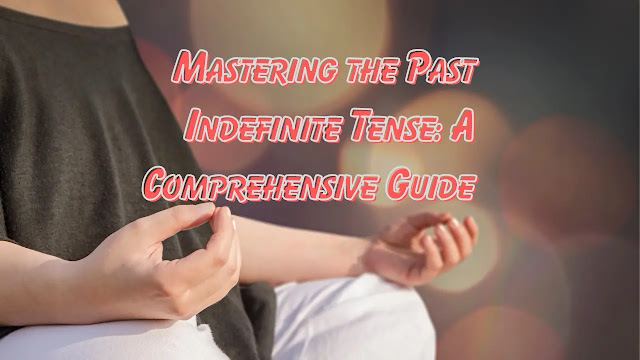Mastering the Past Indefinite Tense: A Comprehensive Guide
Journeying into History: Demystifying 'The Past Indefinite Tense' ⏳📖

Introduction
In the realm of language education, understanding verb tenses is akin to mastering the building blocks of effective communication.
The past indefinite tense, also known as the past simple tense, is a fundamental element of English grammar that enables us to recount events, actions, or states that occurred at a specific point in the past.
Whether you're a student seeking to improve your grasp of this tense, a teacher looking for past indefinite tense worksheets, or simply curious about the intricacies of past simple tense 'be,' this comprehensive guide is your key to unlocking the nuances of the past indefinite tense.
Table of Contents
The Significance of the Past Indefinite Tense
- Communicating Past Events
- Conveying Clarity and Specificity
Past Simple Tense: A Closer Look
- Structure and Formation
- Common Irregular Verbs
Past Indefinite Tense Worksheet: Practical Exercises for Mastery
- Verb Conjugation Practice
- Sentence Construction Challenges
Past Simple Tense 'Be': Unraveling the Mystery
- Usage and Conjugation
- Expressing Identity and Characteristics
Common Errors and Pitfalls to Avoid
- Distinguishing Between Past Tenses
- Subject-Verb Agreement
Practical Tips for Teaching and Learning the Past Indefinite Tense
- Engaging Activities for Classroom Settings
- Effective Self-Study Techniques
FAQs: Addressing Your Questions About the Past Indefinite Tense
Conclusion: Embracing the Richness of Past Narratives
The Significance of the Past Indefinite Tense
Communicating Past Events
The past indefinite tense serves as a linguistic time machine, allowing us to transport ourselves and our listeners to moments in the past. It is the go-to tense for narrating stories, recounting historical events, or simply discussing what happened yesterday.
Conveying Clarity and Specificity
One of the strengths of the past simple tense is its ability to provide clear and specific details about past actions or events. It answers questions like "What did they do?" or "When did it happen?"
Past Simple Tense: A Closer Look
Structure and Formation
Understanding the structure of past simple tense sentences is essential. It typically involves the use of regular verbs in their past form or irregular verbs, which have unique past tense forms.
Common Irregular Verbs
While regular verbs follow predictable patterns to form their past tense, irregular verbs have unique past forms that need to be memorized. Common irregular verbs like 'go,' 'have,' and 'be' are frequently used in past narratives.
Past Indefinite Tense Worksheet: Practical Exercises for Mastery
Verb Conjugation Practice
Past indefinite tense worksheets are valuable tools for practicing verb conjugation. These exercises help students become familiar with the past forms of both regular and irregular verbs.
Sentence Construction Challenges
Constructing past tense sentences can be challenging. Worksheets often include exercises that require students to craft sentences based on given prompts, enhancing their ability to use the tense in context.
Past Simple Tense 'Be': Unraveling the Mystery
Usage and Conjugation
The past simple tense of 'be' (was/were) is a crucial component of English grammar. It is used to describe states or conditions in the past. Understanding its conjugation and usage is essential for accurate communication.
Expressing Identity and Characteristics
'Be' is not limited to describing actions; it also allows us to express identity, characteristics, or affiliations in the past. This versatility makes it a powerful tool for storytelling.
Common Errors and Pitfalls to Avoid
Distinguishing Between Past Tenses
One common error involves mixing past tenses, such as using past continuous when past simple is more appropriate. Learning when to use each tense is vital for precision in storytelling.
Subject-Verb Agreement
Maintaining subject-verb agreement in past indefinite tense sentences can be tricky. Errors like using 'was' with plural subjects or 'were' with singular subjects should be avoided.
Practical Tips for Teaching and Learning the Past Indefinite Tense
Engaging Activities for Classroom Settings
Teachers can employ interactive activities like storytelling, role-playing, and past tense board games to make learning the past indefinite tense enjoyable for students.
Effective Self-Study Techniques
Self-study can be enhanced through techniques such as journaling in past tense, watching movies or reading books in English, and seeking online resources like grammar tutorials and quizzes.
FAQs: Addressing Your Questions About the Past Indefinite Tense
1. What's the difference between past simple and past continuous tenses?
- Past simple describes completed actions in the past, while past continuous focuses on actions that were ongoing at a specific past moment.
2. Are there any shortcuts for remembering irregular past tense verbs?
- Mnemonics, flashcards, and regular practice can help reinforce the memorization of irregular verb forms.
3. How can I improve my past tense storytelling skills?
- Practice storytelling regularly, pay attention to verb tense consistency, and seek feedback from native speakers or teachers.
4. When should I use 'was' or 'were' with 'be' in past tense?
- 'Was' is used with singular subjects (I, he, she, it), while 'were' is used with plural subjects (we, you, they) in past tense.
5. Can I use the past indefinite tense for future events?
- No, the past indefinite tense is specifically for describing past actions or states. For future events, use the future tense.
Conclusion: Embracing the Richness of Past Narratives
- The past indefinite tense, with its ability to transport us to bygone moments, is a treasure trove of storytelling potential.
- Whether you're crafting narratives, teaching eager learners, or simply striving to improve your language skills, mastering this tense opens doors to vivid and compelling communication.
- By delving into its intricacies, practicing consistently, and seeking guidance where needed, you embark on a journey to harness the richness of past narratives in the English language.
PAST INDEFINITE TENSE :-
PAST INDEFINITE TENSE ( STATE OF BEING ).
PAST INDEFINITE TENSE ( USUAL ACTION ).
DEFINITION:- THIS TENSE DESCRIBES THE ACTIONS/ACTIVITIES THAT WERE REPEATED OVER A PERIOD OF TIME OR DONE REGULARLY AGAIN AND AGAIN. SUCH AS ; ROUTINE, HABIT OR SCHEDULED WORK OF PAST.
READ MORE ABOUT : "THE PRESENT PERFECT TENSE" AND : "PRESENT PERFECT CONTINUOUS TENSE"






No comments:
Post a Comment